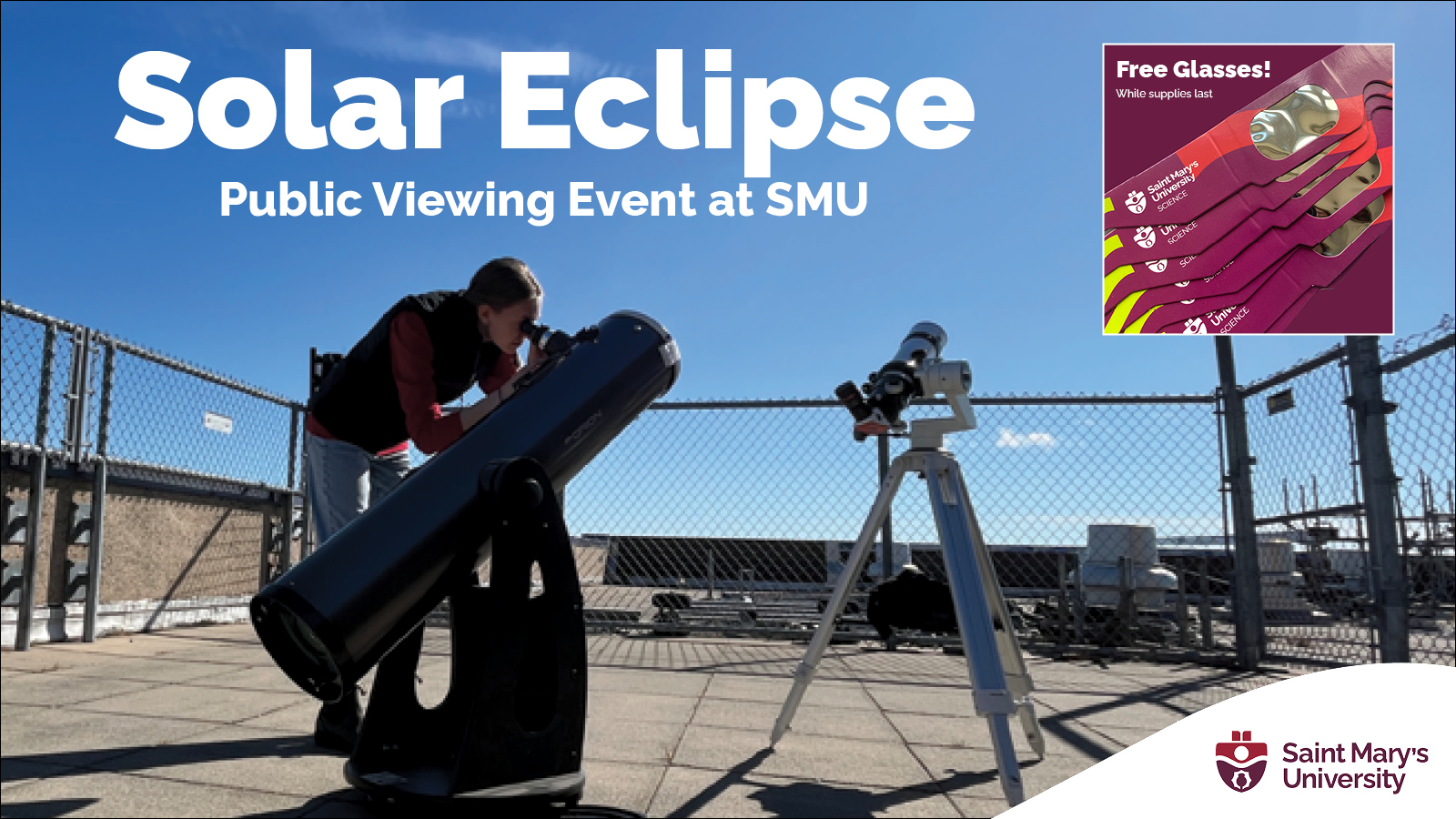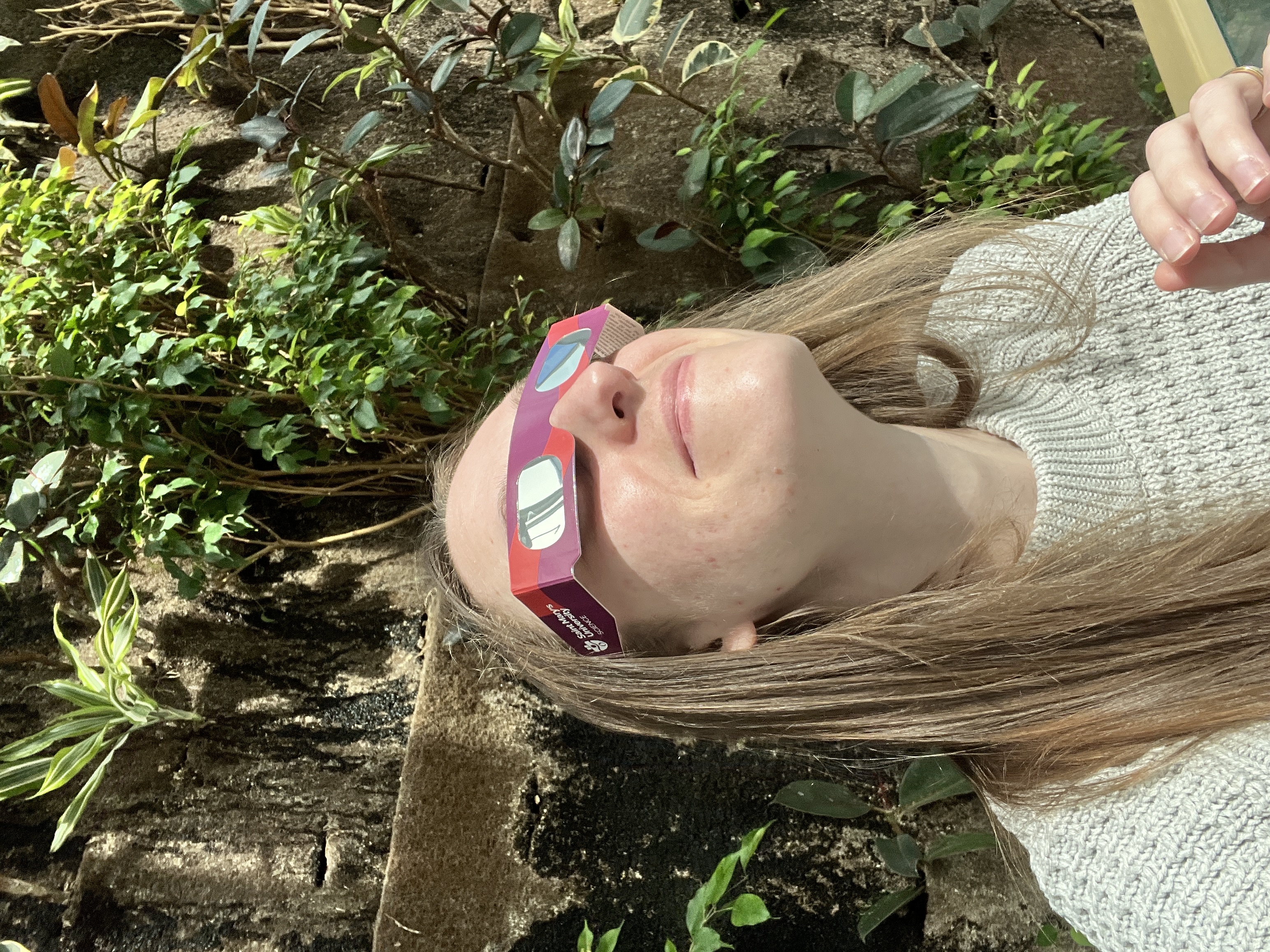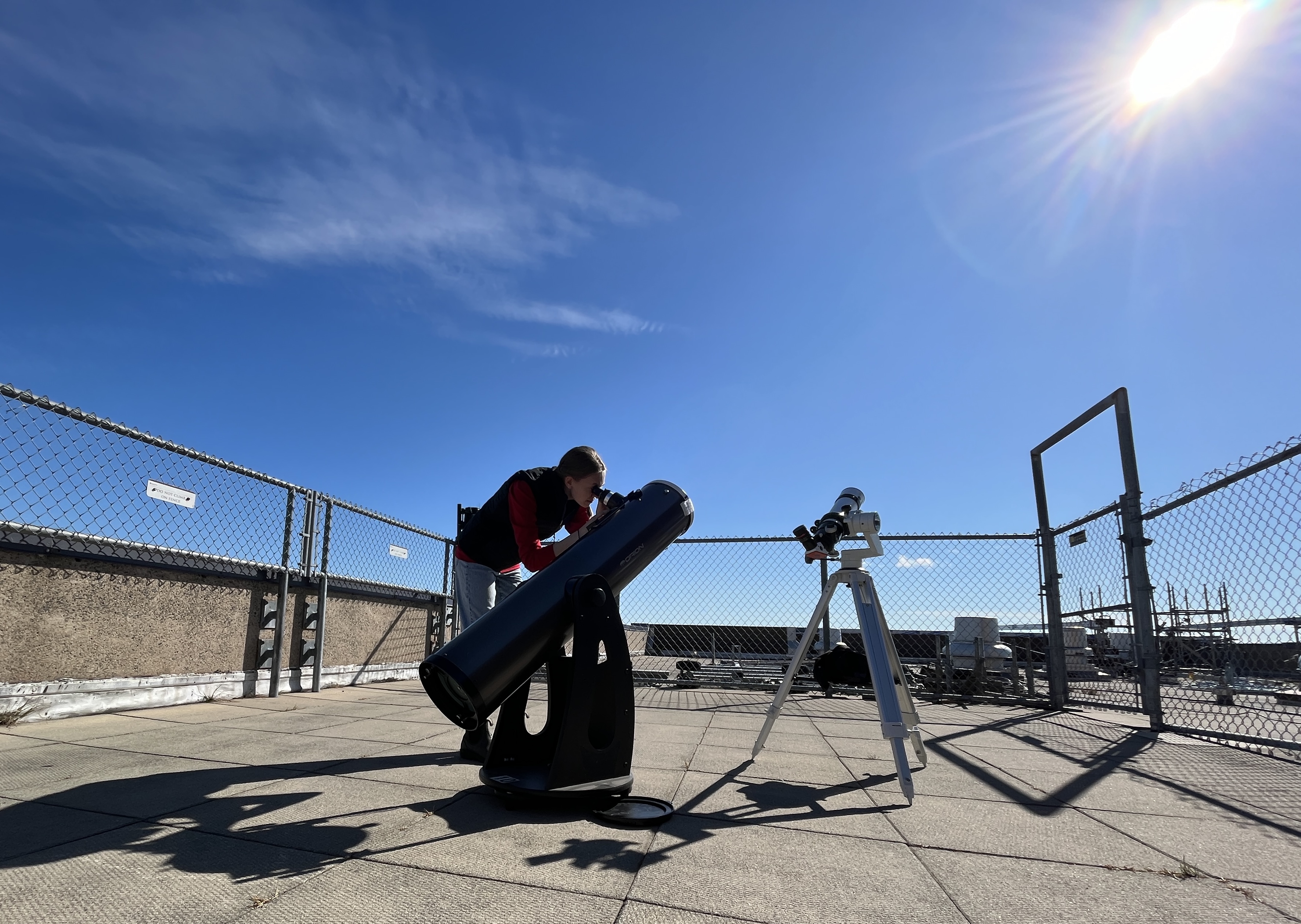Last updated 2024-April-16
What an incredible day we had on Monday, April 8! You can find the original eclipse-information page below, or continue reading here for a brief event recap.

We were so lucky to have a beautiful, warm, sunny day here in Halifax to view the partial solar eclipse on the SMU Huskies football field on April 8th, and to coincidentally celebrate the last day of classes for students at SMU. An estimated 2500-3000 people showed up to observe the partial solar eclipse, which was truly unbelievable. Though we originally reserved 500 pairs eclipse glasses, then added another ~200 pairs of glasses to the pile, we ran out of the eclipse glasses to give away roughly half an hour after the start of the solar eclipse - wow! Luckily, most individuals were happy to share their glasses with others. That wasn't all, though, as we had made some pinhole viewers from cereal boxes and had four 8"-Dobsonian telescopes with solar filters available for use, operated by SMU student volunteers as well as some other equipment (solar binoculars plus another solar telescope) operated by volunteers from Halifax RASC.
Though the event was organized by the Burke-Gaffney Observatory team (Tiffany Fields & Dr. Vincent Henault-Brunet), they were off chasing totality elsewhere on April 8th so the event on the day was led by volunteers from the Department of Astronomy & Physics at SMU (undergraduate students, graduate students, faculty, and staff), volunteers from the student-led Dalhousie Astronomy Society, and volunteers from the Halifax chapter of the Royal Astronomical Society of Canada, as well as other volunteers from the SMU community. Many thanks as well to the volunteers from the Homburg Centre (home of the SMU Huskies) including student athletes that helped the event run smoothly. It was an incredible day!
Saint Mary's University published a recap page with photos, found here.
In the meantime, keep your eclipse glasses! There is another partial solar eclipse over the Maritimes in the morning in late March next year - see here. As long as they are undamaged, you can use your eclipse glasses to look at the sun safely any day it's in the sky. If you'd rather pass along your eclipse glasses, the Burke-Gaffney Observatory is happy to take your extras for outreach events, the Dean of Science office at SMU will take them and pass them along to the Observatory (S221), or there are groups collecting them, as noted on the AAS website.

There is a solar eclipse in the afternoon on Monday April 8, 2024!
You can find the following on this page:
- Information about local eclipse events
- Details about the eclipse in Halifax
- Eclipse Safety & Eye Safety
- Where to get Eclipse Glasses
- Other methods to view the eclipse (pinhole projection!)
- Additional Resources
For more information, you can contact the Observatory about the eclipse using the email address eclipse@observatory.smu.ca or by using the information on the Contact Us page.
Solar Eclipse Viewing Events in Halifax:
Saint Mary's University:
The Astronomy & Physics department plans to host a free event on SMU campus for safe solar observing - with some solar telescopes and eclipse glasses (while supplies last) in the afternoon on Monday April 8, 2024! No registration is required, feel free to come and go as you'd like.
Location: SMU Football Field (entrance gate near Tower Rd, off the Homburg Centre)
Click here for an image of the campus map that includes entrance location
Time: 3:30pm to 5:45pm
Other local eclipse-viewing events on April 8:
- JD Shatford Memorial Public Library, Hubbards NS: 4-5pm, registration required
- Discovery Centre Viewing Event, Halifax, NS, registration required
Other local eclipse-related events, prior to the eclipse:
Eclipse 101 sessions with Astronomer and SMU alum John A. Read at local libraries:
- March 27, 2:30pm @ Tantallon Public Library
- April 2, 7pm @ Woodlawn Public Library
- April 3, 7pm @ JD Shatford Memorial Public Library
Observatory Technician @ SMU Tiffany Fields was on CBC Maritime Noon radio show on April 4 (12-1pm) talking about prepping for the upcoming eclipse and taking calls from listeners, listen here (starting near 17:40).
If you're aware of other events, feel free to Contact Us!
What to Expect from the Solar Eclipse in Halifax:
Halifax is not in the path of totality, but will instead experience roughly 94.3% eclipse so the entire event will require proper eye protection in Halifax. Even though Halifax is not inside the small path of totality, that doesn't mean we're missing the whole event! There will be a partial eclipse to observe from Halifax and most of Nova Scotia.
- Start time (first contact): 3:27pm
- Maximum Eclipse (0.946 magnitude, roughly 94.3% of the sun's disk obscured): 4:38pm
- End time (last contact): 5:44pm
Near the time of maximum eclipse (or roughly ~15 minutes before and after ~4:30pm), I'm hoping local observers will take note of what they see! Do you notice the sky dim slightly? Do you notice a small drop in temperature? Do the shadows on the ground look weird? Take note of what's happening around you.
The website TimeandDate.com has an interactive map for finding eclipse timings for any location along the path.
With updated measurements and calculations, you can check a finalized version of the eclipse path. The path will be slightly narrower than previously thought - only by a few kilometres, but it's worthwhile to check and make sure you're observing from a location in totality or not! (Link shared by Discover The Universe).
Eclipse Safety:
The total solar eclipse will be a spectacular sight! Solar eclipses do not make the sun more dangerous than a normal day, but there is increased temptation to look at the sun during a solar eclipse (understandably!). However, it is not safe to look directly at the sun without proper eye protection, which would include using safe solar filters for binoculars or telescopes or eclipse safety glasses for our eyes. Regular sunglasses are NOT sufficient for observing the sun safely!
- Eclipse Safety Information Sheet
- Video by Discover The Universe about eclipses and eclipse safety
- Eye safety information from the American Astronomical Society
During the eclipse, it is important to use proper ISO 12312-2 compliant eclipse glasses, which are >1000x darker than normal sunglasses. Regular sunglasses are NOT safe to use for any part of a partial solar eclipse. (If you're under totality, though, for example in the middle of New Brunswick, try some polarized sunglasses to look at the corona during the few minutes of totality!) Eclipse glasses compliant with the ISO 12312-2 standard do not expire, but ensure you inspect the glasses before each use (no tears, holes, scratches, etc.) Any eclipse glasses should be worn on top of regular eyeglasses, not below! The eclipse glasses need to be the FIRST surface that the sunlight passes through.
Your eyes don't have pain receptors in them! It is not safe to look at the sun without proper eye protection, and you can seriously damage your eyes by doing so. On a normal day, we typically don't look at the sun because it's just so bright that it's uncomfortable. During an eclipse, don't squint to try to see what's going on with the sun without proper eye protection. If you damage your eyes, you may not feel the effects until the next day or so. And if you do feel "off" with your eyes, get 'em checked out!
Welding filters can also be used to safely observe the sun. A filter shade 12 or higher is safe, though shades 13 and 14 are generally easier to use. Auto-darkening or adjustable welding helmets are not adequate.
Much of the above information summarized from the AAS Eclipse Safety webpage and Science Sam's eclipse safety flyer.
Where to get Eclipse Glasses:

The partial solar eclipse happens slowly over time - between roughly 3:30 and 5:45pm in most of NS. Thus, it's reasonable to share eclipse glasses between groups of family or friends - don't fret if you don't have eclipse glasses for every single person, but rather take turns observing the sun and share them!
Note - I am not currently aware of any place in Halifax (or NS) that is selling eclipse glasses on-site (or online), but if you know of a place, reach out so I can investigate and add to this list!
Purchase eclipse glasses online from:
- List of vendors from the AAS website of vetted eclipse-glasses providers (AAS is the American Astronomical Society, in the US, and there are some Canadian providers listed)
- Indus Space online store
- All-Star Telescope online store
- Funique online store
Or you could purchase directly from an eclipse glasses manufacturer:
Please be careful about where you purchase eclipse glasses, as fake (and unsafe) eclipse glasses are being reported, as noted in this AAS bulletin - please read this if you've bought glasses and are unsure of them. Safe eclipse glasses must comply with the ISO 12312-2:2015 standard. All places named above offer ISO certified glasses and have been vetted, though SMU/BGO/myself have not tested them and are not responsible for eclipse glasses sold or purchased. During the total solar eclipse in 2017, there were counterfeit glasses being sold, claiming they had the correct certification and I'm seeing that happen again. Be very cautious about where you're ordering eclipse glasses from, as not all are made the same and protecting your eyes is of the utmost importance.
If you plan on purchasing eclipse glasses, buy them early! Many distributors are likely to sell out as there are roughly 40 million people that live in the path of totality throughout North American and millions (many millions!!!) more that are expected to observe the solar eclipse on April 8. During the last total solar eclipse to sweep through North America in August 2017, an estimated 88% of all US adults observed the eclipse in some way! This is to say - get your eclipse glasses asap!
Discover The Universe has provided resources online regarding information about eclipse glasses and where to find them.
You don't need a pair of eclipse glasses for everyone in your group. The eclipse lasts over a few hours, and the moon moves slowly over the surface of the sun. Share your glasses with others!
Pinhole Projection:

Using eclipse glasses is fun, but there are other ways to safely observe the eclipse by looking AWAY from the sun, at shadows or images on the ground (yes, really)!
Nathan Coleman from The Weather Network interviewed Observatory Technician Tiffany Fields about making a pinhole viewer out of a cereal box, and that video interview can be found here.
Pinhole viewers can also be made by simply poking a small hole in a piece of paper and observing the image of the sun on the ground. Pinhole viewers are best used by putting your back towards the sun, and looking down towards the ground or another surface. During a "normal" day, the image projected onto the ground of the sun will be a simple circle, as our sun looks like a circle in the sky in our day-to-day lives. During a solar eclipse, however, as the moon passes in front of the sun, the sun instead takes the shape of a crescent. Projecting an image of the sun during a solar eclipse will reveal the changing crescent-shape of the sun over time.
Get creative! Here are some things you can use for pinhole viewers:
- Your hands! Ball your hand into a fist with just a small hole left open
- Your hands! (Part 2): Make a criss-cross pattern with your hands so that there's only small openings between your fingers, like a waffle pattern
- A pasta strainer with many small holes
- A cereal box, as described in the interview with Tiffany Fields
- Any other piece of cardboard
- A leafy tree! Observe the shadows on the ground from the sun
Note: NEVER look through the pinhole AT the sun! Use the pinhole viewers ONLY to observe the image or shadows projected onto the ground or another surface. Check out this article from the AAS about all of the different ways we can observe the sun indirectly by pinhole projection.
John Read at Learn to Stargaze has a quick, easy-to-follow short video about how to make a pinhole projector out of a shoebox.
Additional Eclipse Resources:
Livestreams:
- NASA Livestream of Monday's Total Solar Eclipse (English)
- ASTROLab Livestream from Parc national du Mont-Mégantic, Quebec (French)
Resources:
- Our SMU Physics Demos website has an article and video illustrating how eclipses happen, and the video is shown at the bottom of this page
- The Royal Astronomical Society of Canada has information about eclipses and lists events that are being held throughout Canada for the total solar eclipse
- Local to Halifax, the Discovery Centre has a full page with videos and other information about the upcoming solar eclipse, including eclipse safety and educational resources
- Discover The Universe has resources and information for educators about the upcoming eclipse, including safety information in both English and in French
- TimeandDate.com has an interactive map of the eclipse path, including the path of totality
- Eclipse2024.org has a variety of resources about eclipse path, timelines, and more
- Canadian Space Agency is providing information about the upcoming eclipse
- Eclipse Quebec Online website (information for all of Canada in addition to Quebec-specific info)
- American Astronomical Society website about the April 8 eclipse, including their page about how to safely view the eclipse
- The Clear Sky Chart website has a page of clear sky charts along the path of totality and their likelihood of clear skies
- Canadian Association of Optometrists has a 1-page PDF about safe solar eclipse viewing
- Eclipse2024.org has simulators for different locations, and here's the simulation for the eclipse in Halifax
Other media:
- Interview with Tiffany Fields & The Weather Network's Nathan Coleman, illustrating how to make a pinhole projector
- Interview with Tiffany Fields & Allister Aalders from SaltWire/The Chronicle Herald about the upcoming eclipse
- (French) Interview with Dr. Vincent Henault-Brunet & CBC Radio Canada about the upcoming eclipse
- Interview with Tiffany Fields & Global TV about the upcoming eclipse
- Interview with Tiffany Fields & Bob Murphy on CBC Maritime Noon about the eclipse, including answering questions from callers
- Interview with Tiffany Fields & Tom Murphy for CBC regarding the eclipse and safety
The most important information: DO NOT LOOK AT THE SUN WITHOUT PROPER EYE PROTECTION, SUCH AS ECLIPSE GLASSES. The safest way to look at the sun is to NOT LOOK AT IT DIRECTLY AT ALL, AND INSTEAD OBSERVE THE SHADOWS ON THE GROUND. The student in the photo below had a special solar filter on the telescope allowing for safe observation.

